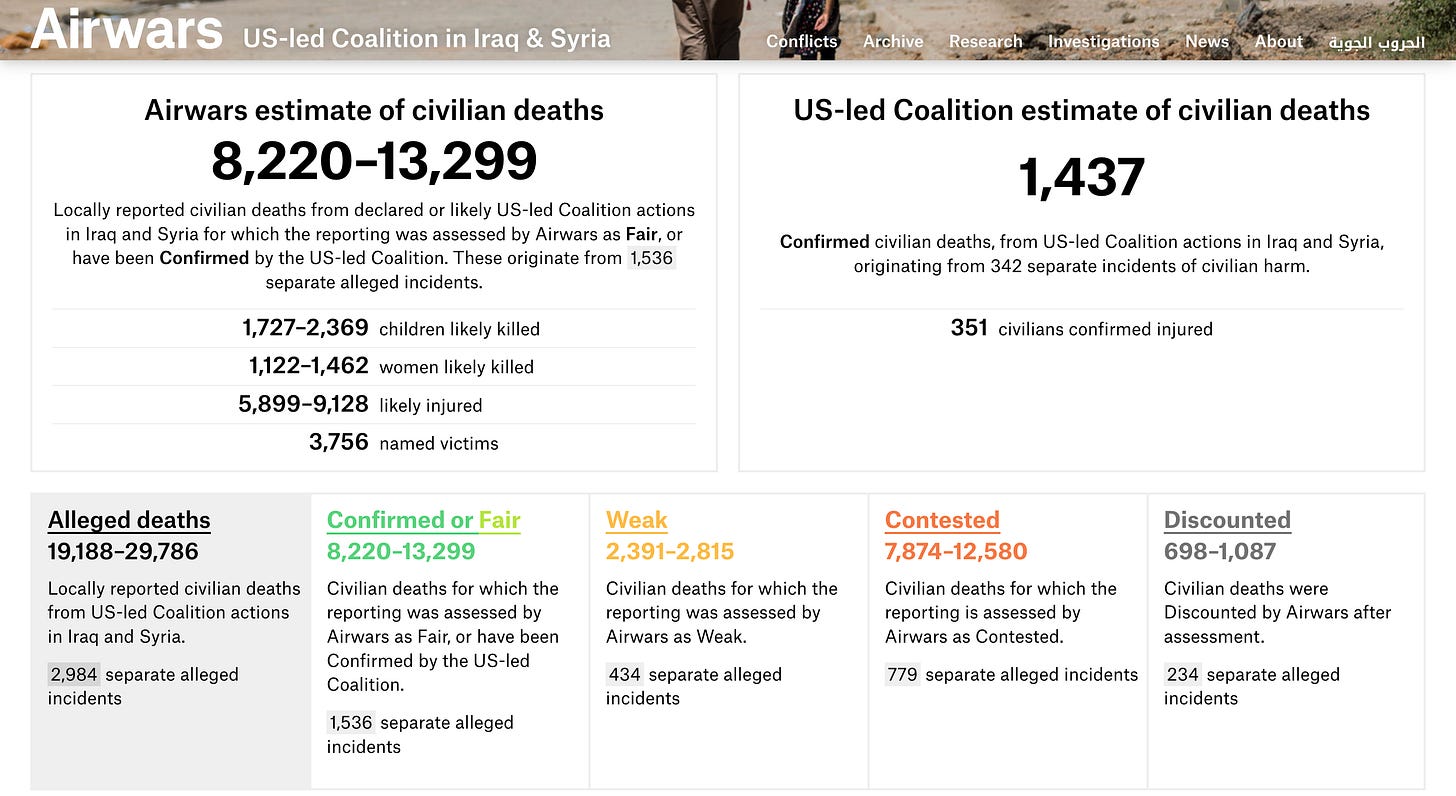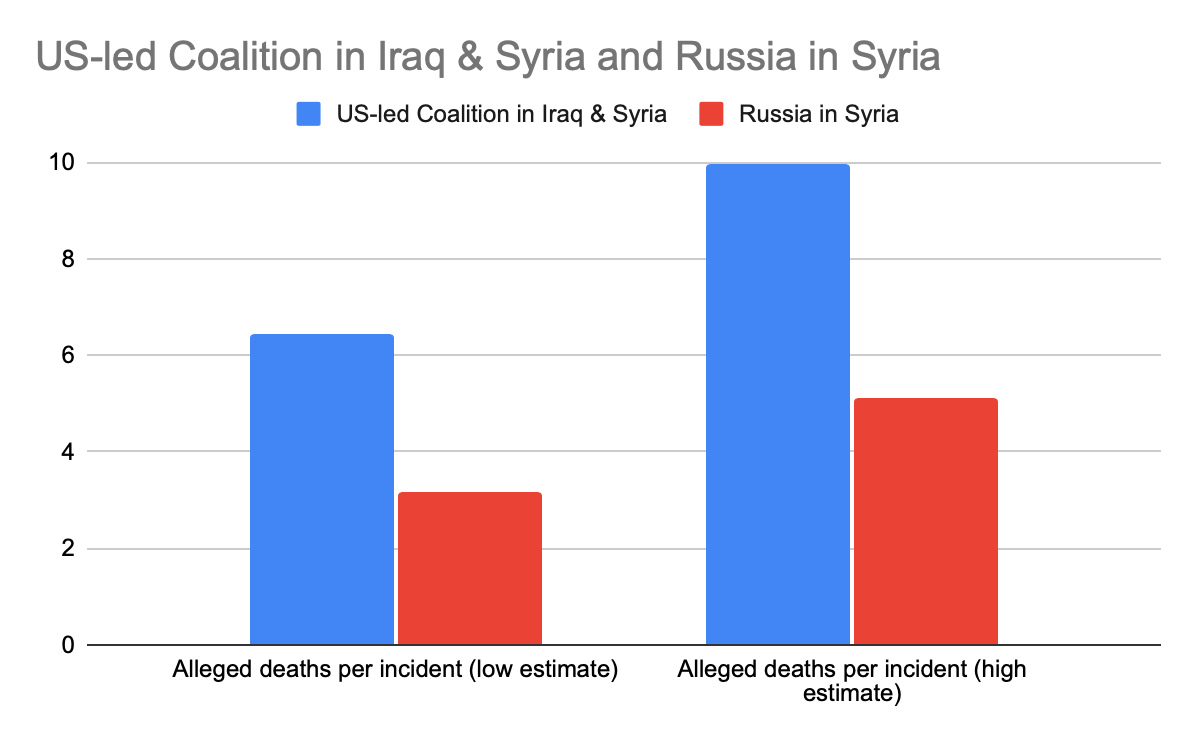Comparing Russian and US Airstrikes: Which are More Dangerous for Civilians?
Examining the data gives us a clear answer

You look up at the sky and see a military aircraft with a flag that is red, white, and blue but you can’t quite tell which country it is. With the sound of bombs falling and exploding, you suspect that only two countries are likely to have the capability and the will to carry out airstrikes in your homeland. As a civilian in a conflict zone, which poses a greater threat to your life, the United States of America or the Russian Federation?
By looking at information from the London-based organisation Airwars, the data suggests that you would probably be safer if those pilots above you were Russian. Let’s examine the data by comparing the figures from the wars in Iraq, Libya, and Syria.
In terms of raw numbers, the United States has likely killed far more civilians than Russia. However, this is to be expected given that the United States has carried out airstrikes in more places for a longer time with a larger fleet of aircrafts. Here are some of the overall figures for the airstrikes in the Middle East:
First, some important caveats.
It is worth noting that in these conflicts there were multiple nations involved. For our purposes, given the fact that the leader in bombings in US-led missions (Libya as well as later Iraq & Syria) is the United States and supposing that civilian casualty rates inflicted are similar those of its allies, like the United Kingdom and France, we can go ahead and assume that the figures for the US mirrors that of the overall figures. In the case of Libya, by early May 2011 (the intervention having begun in March 2011) the United States carried out ca. 2,000 out of 5,857 sorties, or roughly 34% of the overall total. Along with the UK, France, and Italy, the four were responsible for 87% of sorties. Given that these countries are long-standing allies with decades of cooperation and similar operating procedures, we can assume with reasonable confidence that the figures derived from the Libyan dataset apply to the United States. In the case of the North African conflict, the Libyan Air Force was essentially non-existent for the majority of the conflict as the NATO intervention began by focusing on establishing a no-fly zone over the country.
Knowing that the Syrian military flies the same type of aircrafts as the Russian Air Force, it is possible that some of these “Russian” strikes were actually Syrian but let’s count them all as Russian here in order to be consistent and be as cautious as possible.
The first thing that you may notice is the sheer range of possible civilian deaths. For the sake of simplicity and rigour, let’s focus on the numbers coded as “confirmed or fair.” Here are the definitions Airwars gives for the two terms:
Confirmed
A specific belligerent has accepted responsibility for the killing or injuring of non-combatants or allied forces in a particular incident.Fair
Where, in the view of Airwars, there is a reasonable level of public reporting of an alleged civilian casualty incident from two or more credible sources (often coupled with biographical, photographic or video evidence). Crucially, this includes likely or confirmed actions by a belligerent in the near vicinity for the date in question. We believe these cases, in particular, require urgent investigation.
In order for the numbers to be comparable, we need to figure out the number of civilian deaths per incident.
(In this case, it is per incident where there has been at least one civilian casualty. Consequently, it is does not include incidents where only combatants are killed.)
Airstrikes in Iraq and Syria
In the case of the US-led coalition in Iraq and Syria we get a low estimate of 5.35 civilian deaths per incident and a high estimate of 8.61 civilian deaths per incident.
What about for the Russians in Syria? The lower end estimate for them is even lower at 3.19 civilians per incident while the higher one stands at 4.73 per incident. In other words even the high estimate for the Russians is lower than the low estimate for the United States and its allies.
But you may object to this on the basis that counting only civilian deaths deemed to be confirmed or coded as fair is far too narrow. Assuming that all alleged civilians deaths were in fact caused by the United States and Russia, we get the following low and high-end estimates:
US-led coalition in Iraq & Syria: 6.43-9.98
Russian military in Syria: 3.19-5.12
Using this broader estimate, the number of civilians per incident killed by the United States increases. Meanwhile, the Russian figure is virtually the same with the entire Russian range falling below the low estimate for the United States.
But deaths are not the only risk in war as injuries are commonplace as well so let’s compare the number of likely injured per incident (looking at the same incidents):
US-led coalition in Iraq & Syria: 3.84-5.94
Russian military in Syria: 4.83-7.57
Comparing the civilian deaths per incident with likely injured per incident we get rather different results. In the case of the US-led coalition strikes in Iraq and Syria, on average more civilians were killed than injured. By contrast the Russians were more likely to injure civilians than to kill them.
In other words, the Russian military kills fewer civilians per incident and are more likely to injure as opposed to kill civilians than US military and the armed forces of Washington’s allies.
If we combine civilian deaths (confirmed/fair) and likely injured in order to calculate total civilian casualties per incident, we see that the overall trend between the bombing campaigns largely holds, though the gap between the US and Russia somewhat narrows in the Middle East:
US-led coalition in Iraq & Syria: 9.19-14.6
Russian military in Syria: 8.02-12.29
Comparing Regime-change Conflicts
How do civilians fare when the goal of the airstrikes is to replace the government?
You may be wondering what the figures are for Russia’s airstrikes in Ukraine. For this, Airwars’ dataset is far more limited as it only looks at a few months in Kharkiv/Kharkov Oblast but it is still illuminating.
Using the same methodology as above we can calculate the following figures:
Civilian deaths (confirmed/fair) per incident: 1.99-2.76
Likely injuries per incident: 3.14-5.03
Total casualties per incident: 5.13-7.79
Meanwhile, in the case of the 2011 Libyan War, we start with these figures:
With some quick mathematics, we arrive with the following conclusions:
Civilian deaths (confirmed/fair) per incident: 10.08-21.72
Likely injuries per incident: 9.04-13.87
Total casualties per incident: 19.05-35.59
In other words, if we took a conservative approach by only using the low-end estimates, then it would appear to be the case that five times as many civilians were killed per incident in Libya and 2.9 times as many civilians were injured in Libya compared to incidents that involved the Russian military in Kharkiv/Kharkov Oblast. Using the high-end estimates, this would amount to 7.9 times as many civilians killed per incident and 2.8 times as many injured per incident.
Possible Explanations
On the whole it appears as if the Russians are causing fewer civilian casualties per incident. One potential reason for this is that the Russian military relies less on sheer airpower. In the case of US bombings in Syria and Libya, most military activity was from the air (especially with the latter), which may result in Washington having a more intensive bombing campaign that in turn leads to more civilian deaths. Meanwhile, the Russians are able to coordinate with their Syrian allies or their own forces on the ground and thereby be more precise. Additionally, especially in Ukraine, Russia has relied more on artillery.
Another potential explanation is urban density. Libya has the highest urban density of the four countries examined so it stands to reason that it would have the highest civilian casualty rate. On the other hand, Ukraine’s urban population as a percentage of the total population is only slightly behind Iraq’s and significantly higher than Syria’s but still has by far the lowest civilian casualty rate, so urban density cannot explain all of it. Furthermore, the Syrian government controlled many of the urban centres already (like Damascus) whereas in Ukraine the Russians had greater control of non-urban areas, further complicating the effect of urban density on civilian casualties.
Another possibility is that areas bombed by the United States are more likely to report civilian deaths. But from a technological and geographic perspective, one would then expect Ukraine to have a higher reporting capacity. The data collected by Airwars relied on open source reporting, which benefits from higher levels of internet penetration. However, internet usage rate seems to have little correlation with the rates of reported civilian casualties. Only 11% of Libyans were using the internet in 2011 compared to 79.2% of Ukrainians in 2021 yet the former witnessed far more reported civilian casualties per incident than the latter. If anything, this would suggest that the disparity between Libya and Ukraine would be even greater if internet access is a major factor. Furthermore, until 2018 Syria had higher levels of internet usage than Iraq yet Syrians were less likely to be killed per incident by Russians than Iraqis and Syrians facing the US-led coalition during the same period.
Final Takeaway
If you are a civilian living through aerial bombardment, your best bet for not being killed is if Russians, and not Americans, are the ones doing the bombing.













